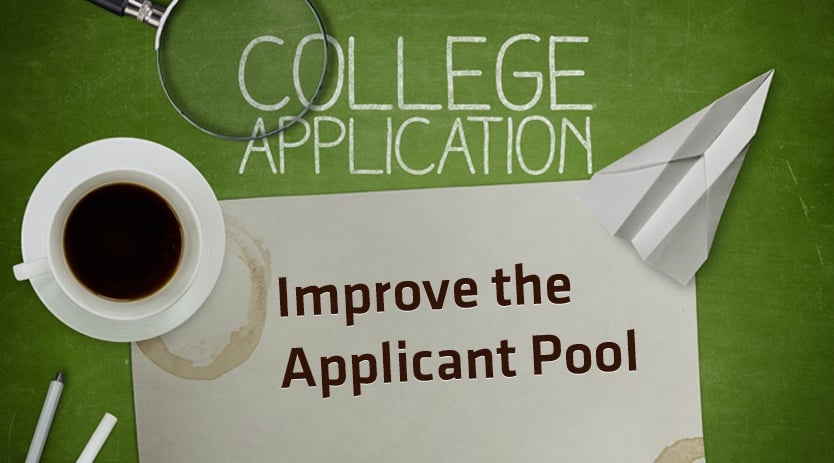Beyond a college’s faculty, its lifeblood is its student body. This is built, piece-by-piece, by a series of applicant pools that yield matriculated students. Thus, better applicant pools will, over time, result in a better student body.
Improve the applicant pool
So, what makes for a better applicant pool? While the simplest to comprehend metric for a college’s applications is the size of the applicant pool, what the college really desires is an applicant pool composed solely of people who both are highly qualified and want to attend this college more than others (i.e., have a high “intent to attend”). For most colleges it is never the case that they do not need to improve in either one or the other, no matter how sophisticated their marketing and/or recruitment efforts. What I propose here is a way to improve a student body through efforts that transparently expose the college’s faculty and programs to potential applicants. A series of SPOCs and MOOCs can be the cornerstone of a college’s efforts at improving its applicant pool in both its quality and intention-to-attend.
Improving the quality of applicants
For many schools two dimensions of an application are most involved with disqualifying an applicant from consideration: 1) the applicant’s mathematical ability, and 2) the applicant’s writing ability. A particular school will probably have an issue with one more than the other, so it should focus its efforts on that dimension. The tool to address quality is a series of MOOCs and/or SPOCs that enable the applicant to improve the problematic weakness while also getting him/her to the school’s faculty (and possibly current staff and students).
The school should also decide on the target learner — do you want to go after the applicants who have yet to commit to the school or the applicants who have already committed to matriculating? The decision here will determine much about the pedagogy of the course(s), the resources needed to successfully execute the course(s), the content of the course(s), and the goal of the course(s). If the school needs help attracting applicants, then it should choose the first; if it is mostly satisfied with the number of applicants but has a lower yield rate (or eventual graduation rate), then it should target the second.
The basic outline of a program to improve applicant quality is the following:
- Recruitment of faculty whose backing is necessary for the success and acceptance of the program
- Definitions of the content that students need to master (for whatever purpose)
- Definitions of assessments that would determine when students have reached an appropriate level of mastery
- Creation of course resources (videos, readings, projects, etc.)
- Assemble the team needed to run the course, assess the students, and provide on-going support and feedback — roping in admissions and student services staff as well as current students should all be considered
- Follow the applicants through the applicant cycle (and, hopefully, their time at the school) to determine the relative success of these applicants
Decisions that remain include whether or not to incorporate CBE, adaptive learning, or social learning into the effort. Clearly, this is a major effort but the outcome should be applicants who are better prepared to succeed at the school.
Improving an applicant’s intent-to-attend
Improving the overall intent-to-attend for an applicant pool would probably have a bigger impact on the whole admissions process than any other type of improvement. It is quite discouraging for an admissions team to take a large chunk of time reading and evaluating hundreds, if not thousands, of applications from people who have no intent to attend the school unless dire circumstances arise (i.e., the student is not accepted at any of their other top choices; i.e., this school is a backup choice for the applicant who, literally, would rather attend anywhere else other than this school). Further, weeding out applicants who have no intention of attending would allow the school’s financial aid staff to award gifts and grants to students whom they have a chance of landing.
The focus of this class (or program) should be on two things:
- The school’s most popular and distinctive academic programs
- The faculty who make those programs so successful
Certainly, the school’s marketing efforts already are concentrated on both of these. (If they aren’t, then why are you reading this article? Go talk to your marketing team and get them on it!) Online learning experiences that expose both the school’s programs and faculty to possible applicants in an engaging way should give potential applicants a clearer picture of the benefits of attending the school, thereby allowing them to more accurately discern whether or not the school is a fit for the student.
In addition to the focus on the popular programs and successful faculty, the course should also find ways of integrating important staff (e.g., the head of career development) and impressive young alumni and/or upperclass students. All of these people can be used as mentors, coaches, and/or discussion leaders during the course. These additional participants should help students round out their evolving picture of the school.
Conclusion
If a college wants a quality student body, then it can take steps to improve the quality of the applicants either before or after they choose to attend. Further, the college can also work to ensure that students who might apply to the school are informed enough to make a quality decision on whether or not they want to attend...before they apply. The result of these steps should be a better student body who is excited about being at the college. And what college president, provost, or faculty member doesn’t want to deal with one of those?
If you’re interested in discussing the possibilities for rolling out a series of SPOCs and MOOCs in order to improve the applicant pool for your institution, please email Scott Moore or set up an appointment directly.


